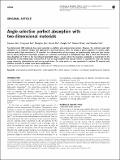| dc.contributor.author | Zhu, Linxiao | |
| dc.contributor.author | Liu, Fengyuan | |
| dc.contributor.author | Lin, Hongtao | |
| dc.contributor.author | Hu, Juejun | |
| dc.contributor.author | Yu, Zongfu | |
| dc.contributor.author | Wang, Xinran | |
| dc.contributor.author | Fan, Shanhui | |
| dc.date.accessioned | 2017-10-13T20:30:10Z | |
| dc.date.available | 2017-10-13T20:30:10Z | |
| dc.date.issued | 2015-12 | |
| dc.date.submitted | 2015-11 | |
| dc.identifier.issn | 2047-7538 | |
| dc.identifier.uri | http://hdl.handle.net/1721.1/111847 | |
| dc.description.abstract | Two-dimensional (2D) materials have great potential in photonic and optoelectronic devices. However, the relatively weak light absorption in 2D materials hinders their application in practical devices. Here, we propose a general approach to achieve angle-selective perfect light absorption in 2D materials. As a demonstration of the concept, we experimentally show giant light absorption by placing large-area single-layer graphene on a structure consisting of a chalcogenide layer atop a mirror and achieving a total absorption of 77.6% in the mid-infrared wavelength range (~13 μm), where the graphene contributes a record-high 47.2% absorptivity of mid-infrared light. Construction of such an angle-selective thin optical element is important for solar and thermal energy harvesting, photo-detection and sensing applications. Our study points to a new opportunity to combine 2D materials with photonic structures to enable novel device applications. | en_US |
| dc.publisher | Springer Nature | en_US |
| dc.relation.isversionof | http://dx.doi.org/10.1038/LSA.2016.52 | en_US |
| dc.rights | Creative Commons Attribution-Noncommercial-Share Alike | en_US |
| dc.rights.uri | http://creativecommons.org/licenses/by-nc-sa/4.0/ | en_US |
| dc.source | Nature | en_US |
| dc.title | Angle-selective perfect absorption with two-dimensional materials | en_US |
| dc.type | Article | en_US |
| dc.identifier.citation | Zhu, Linxiao, et al. “Angle-Selective Perfect Absorption with Two-Dimensional Materials.” Light: Science & Applications 5, 3 (December 2015): e16052 © 2017 Changchun Institute of Optics, Fine Mechanics and Physics | en_US |
| dc.contributor.department | Massachusetts Institute of Technology. Department of Materials Science and Engineering | en_US |
| dc.contributor.mitauthor | Lin, Hongtao | |
| dc.contributor.mitauthor | Hu, Juejun | |
| dc.relation.journal | Light: Science & Applications | en_US |
| dc.eprint.version | Final published version | en_US |
| dc.type.uri | http://purl.org/eprint/type/JournalArticle | en_US |
| eprint.status | http://purl.org/eprint/status/PeerReviewed | en_US |
| dc.date.updated | 2017-10-11T17:52:42Z | |
| dspace.orderedauthors | Zhu, Linxiao; Liu, Fengyuan; Lin, Hongtao; Hu, Juejun; Yu, Zongfu; Wang, Xinran; Fan, Shanhui | en_US |
| dspace.embargo.terms | N | en_US |
| dc.identifier.orcid | https://orcid.org/0000-0002-7233-3918 | |
| mit.license | PUBLISHER_CC | en_US |
